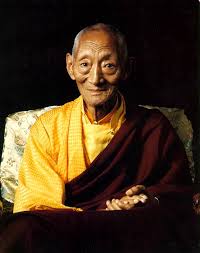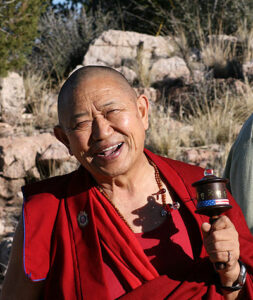The Vajrayana practice is entered through an empowerment.

Kalu Rinpoche–Secret Buddhism/Vajrayana Practices
To be efficient, the empowerment requires the realization of the master who confers it, as well as confidence and intelligence of the disciple who receives it. These empowerments take the form of various rituals of greater or lesser complexity. During the empowerments of the great tantric deities, the most common and elaborate versions of the empowerment are characterized by making a mandala of colored sands. A version of medium complexity will use a mandala painted on cloth. A simpler version will use a mandala made of small heaps of rice. Finally, in an empowerment reduced to its essential version, the body of the master who gives the empowerment or a simple mental representation is sufficient to symbolize the mandala.
The four stages of an empowerment
An empowerment in its most complete form includes four subsections called the four empowerments. – vase empowerment – secret empowerment – wisdom-knowledge empowerment -fourth empowerment or empowerment of the precious word Simplified forms of empowerments are limited to transmission of the body, speech, or mind of the deity, or only to the vase empowerment. However, empowerment, in the full sense of the term, implies the four subsections just mentioned. It is only in those circumstances that the samayas play a complete role and must be scrupulously respected for the transmission of grace to open the door of accomplishments.
Preparatory phases
The lama charged with giving an empowerment must, first of all, conform to the reference tantra stated by the Buddha by preparing the mandala that will serve as support. This mandala can be a sand mandala, a painted mandala, or a mandala composed of small heaps of rice symbolically placed on a base. Officiating alone, the lama executes a part of the ritual in three preparatory phases.
- The dakye, where the lama visualizes himself or herself in the form of the deity
- The dunkye, where the lama visualizes the deities in space.
- The bumkye, where the lama consecrates the vase of empowerment, visualizing it as a celestial palace where the deities of the empowerment reside.
- Finally, a fourth preparatory phase is added. The lama confers the empowerment on himself or herself (dajuk).
Only after this are the disciples admitted in the temple to receive the empowerment.
Vase empowerment
The disciple first receives the vase empowerment, conferred on the body. This introduces the disciple to the pure nature of the different constituents of his or her psycho-physical personality. There are the five aggregates, the five elements, or the factors of perception. This empowerment is given with the help of ritual objects, symbolizing the five masculine Buddhas-such as the crown, vajra, bell, and so on. By this process, faults and veils related to the body are dissipated and the constituents of the personality become the corresponding pure aspects: the five masculine Buddhas, five feminine Buddhas, eight great feminine and masculine Bodhisattvas, and so on. This empowerment gives the power to meditate with our own body in the form of the deity’s body, and will ultimately lead us to achieve the body of emanation (nirmanakaya).
Secret empowerment
The second empowerment, secret empowerment, conferred on speech, is transmitted by consecrated alcohol that becomes ambrosia (Tibetan, dutsi), contained in a skullcap. The disciple drinks a few drops. This empowerment purifies faults and veils related to speech, bestows the power to recite the deity’s mantra, and allows one to ultimately achieve the body of perfect experience (sambhogakaya).
Wisdom-knowledge empowerment
The third empowerment, wisdom-knowledge empowerment, conferred on mind, is transmitted by a wisdom-knowledge (Tibetan, rikma) that is to say, a young woman, painted, for the sake of the ritual on a small card. This empowerment purifies faults and veils related to mind and bestows the power to meditate on the union of bliss and emptiness, and to ultimately achieve the absolute body (dharmakaya).
For an empowerment to have real effect, it is necessary, of course, that certain external conditions be met. It is also necessary that the lama who gives it has received authentic transmission and executes the ceremony with accuracy, without adding or removing anything. Finally, it is necessary that disciples who receive it have full confidence in the lama, some understanding of the process, and conviction in its efficiency.
Empowerment of the precious word The fourth empowerment, empowerment of the precious word, does not use ritual objects but consists of an oral introduction to the mode of being of the mind and all phenomena. Its impact is located at the level of simultaneousness-simultaneous purification of faults and veils of body, speech, and mind. It also permit simultaneous meditation of one’s body as the deity’s body, one’s speech as the deity’s mantra, and one’s mind as the state of absorption. Ultimately, it leads to the realization of the body of essence itself (svabhavakaya), the union of the three other bodies of Awakening.The sutra approach of Mahayana and the tantra approach of Vajrayana lead to the same goal, but with different time scales. It is said that the practitioner must practice three immeasurable kalpas before reaching Awakening through the sutra path. It is said that a maximum of sixteen lifetimes is necessary for obtaining the same result through the tantra path. As for a minimum, it varies according to texts. Some say six months, others six or twelve years, but in any case Awakening is realized in the framework of this lifetime.
– Kalu Rinpoche–Secret Buddhism/Vajrayana Practices



